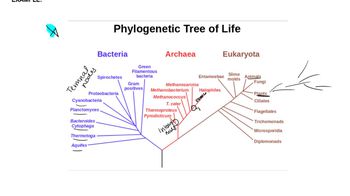Table of contents
- 1. Introduction to Genetics51m
- 2. Mendel's Laws of Inheritance3h 37m
- 3. Extensions to Mendelian Inheritance2h 41m
- 4. Genetic Mapping and Linkage2h 28m
- 5. Genetics of Bacteria and Viruses1h 21m
- 6. Chromosomal Variation1h 48m
- 7. DNA and Chromosome Structure56m
- 8. DNA Replication1h 10m
- 9. Mitosis and Meiosis1h 34m
- 10. Transcription1h 0m
- 11. Translation58m
- 12. Gene Regulation in Prokaryotes1h 19m
- 13. Gene Regulation in Eukaryotes44m
- 14. Genetic Control of Development44m
- 15. Genomes and Genomics1h 50m
- 16. Transposable Elements47m
- 17. Mutation, Repair, and Recombination1h 6m
- 18. Molecular Genetic Tools19m
- 19. Cancer Genetics29m
- 20. Quantitative Genetics1h 26m
- 21. Population Genetics50m
- 22. Evolutionary Genetics29m
22. Evolutionary Genetics
Phylogenetic Trees
Problem 22a
Textbook Question
Examine Figure 1.17 and answer the following questions.
What characteristics are shared by the mammalian clade and the primate clade? What characteristic distinguishes the primates from other members of the mammalian clade?
 Verified step by step guidance
Verified step by step guidance1
Identify the characteristics of the mammalian clade. These typically include traits such as the presence of mammary glands, hair or fur, and three middle ear bones.
Identify the characteristics of the primate clade. Primates often have traits like large brains relative to body size, forward-facing eyes, and opposable thumbs.
Compare the characteristics of the mammalian clade with those of the primate clade to determine which traits are shared. Look for common features such as mammary glands and hair.
Determine which characteristics are unique to the primate clade and not found in other mammals. Focus on traits like opposable thumbs and enhanced vision.
Summarize the shared characteristics and the distinguishing features of primates compared to other mammals.
Recommended similar problem, with video answer:
 Verified Solution
Verified SolutionThis video solution was recommended by our tutors as helpful for the problem above
Video duration:
1mPlay a video:
Was this helpful?
Key Concepts
Here are the essential concepts you must grasp in order to answer the question correctly.
Mammalian Clade Characteristics
The mammalian clade is characterized by features such as warm-bloodedness, hair or fur, and mammary glands that produce milk for offspring. These traits are essential for survival and reproduction, allowing mammals to thrive in diverse environments. Understanding these characteristics helps in identifying shared traits among mammals.
Recommended video:
Guided course

Cancer Characteristics
Primate Clade Characteristics
Primates, a subgroup within the mammalian clade, exhibit unique characteristics such as flexible limb structure, enhanced vision, and larger brain-to-body size ratios. These adaptations facilitate complex behaviors and social structures. Recognizing these traits is crucial for distinguishing primates from other mammals.
Recommended video:
Guided course

Cancer Characteristics
Evolutionary Relationships
The evolutionary relationships among species are often depicted in phylogenetic trees, which illustrate how different clades share common ancestors. Understanding these relationships helps clarify how certain traits evolved and how they differentiate groups like primates from other mammals. This context is vital for answering questions about shared and distinguishing characteristics.
Recommended video:
Guided course

Phylogenetic Trees

 8:16m
8:16mWatch next
Master Phylogenetic Trees with a bite sized video explanation from Kylia Goodner
Start learningRelated Videos
Related Practice

